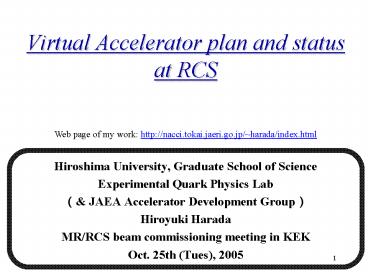Virtual Accelerator plan and status at RCS - PowerPoint PPT Presentation
1 / 17
Title:
Virtual Accelerator plan and status at RCS
Description:
1. Virtual Accelerator plan and status at RCS. Hiroshima University, ... Side band by Synchrotron Oscillation. 13. The location of the exciters at RCS. 14 ... – PowerPoint PPT presentation
Number of Views:52
Avg rating:3.0/5.0
Title: Virtual Accelerator plan and status at RCS
1
Virtual Accelerator plan and status at RCS
Web page of my work http//nacci.tokai.jaeri.go.j
p/harada/index.html
- Hiroshima University, Graduate School of Science
- Experimental Quark Physics Lab
- ( JAEA Accelerator Development Group)
- Hiroyuki Harada
- MR/RCS beam commissioning meeting in KEK
- Oct. 25th (Tues), 2005
2
Plan for virtual accelerator
- 1. Estimation of the best K value of each magnet
from matching by simulation code - 2. Estimation of the measurement method of each
parameter and the beam elements condition from
the monitor's signal by the tracking. ?
Reflection to real measurement. - 3. Estimation of the beam loss by MARS .
3
Control Model by VA
Operation
panel with GUI
Start virtual operation
Set Magnets
The signal of each monitor
the signal of each monitor
Operating Log DB Operating parameter
DB1(DB for elements)
IOC Interface Power Source
Physics value?Device value Transformation
parameters
Position information of the elements
EPICS Channel name
EPICS
PCAS
IOC
Simulation Input File
Simulator
SAD SIMPSONS STRUCT/MARS
Element
Real Accelerator
Virtual Accelerator
4
Plan 1 operation and matching
- Matching will be carried out by SAD, but maybe
switch to JAD in the future. - Operation panel with GUI for commissioning will
be created by JAD (script by java based SAD)
until the comprehensive examination of RCS around
Dec. 2006. - The GUI operation panels for each operating mode
and scenario will be created. - This will carry out COD correction and search
of the best K1 tune by tune, etc.
5
Sample GUI by KBFrame
6
Plan 2 examination of measurement method of
each parameter by VA
- The measurement of the tune (now in progress)
- The measurement of the chromaticity (now in
progress) - The measurement of the dispersion function
- The measurement of the Beta function
- The measurement of all other parameters
7
Plan 3 estimation of beam loss
- The estimation of the beam loss will be
calculated by MARS, using the results from the
tracking by Simpsons. - The other thing than those above is unknown yet.
8
Status for VA
- VA system via EPICS PCAS
- - Preliminary system was created.
- System to create the input files for simulation
code from DB - - Trace3D, SAD, MAD and XAL only QM and BM
was created by Sako-san. - Examination of measurement method for each
parameter - - Measurement for tune and chromaticity is
now in progress. - Integration of simulation codes (SAD, Simpsons
and MARS) - - The communication between EPICS and
Simpsons is now in progress.
9
The construction of system The control system
of simulation code via EPICS PCAS
GUI Operation panel (by KBFrame)
Monitor signal
K1 value
EPICS PCAS
Monitor signal
K1 value
Simulator
EPICS Experimental Physics and Industrial
Control System PCAS Portable Channel Access
Server
Figure. A created the sample operation panel with
GUI
10
(No Transcript)
11
Fourier transform
12
Measurement of the tune
- For the beam condition,
- ex, y 216 pi mmmrad
- Number of particles 4800
- Spread of the dp/p 1
- Length of the bunch about 83 m
- Non space charge
- Non fluctuation of the BPMs
13
The location of the exciters at RCS
14
The exciter at RCS
The exciter gives the beam the kick with ?x at a
point in RCS ring turns by turns.
?rms is the kick-angle by the exciter, p is the
beam momentum, ß is Lorenz beta, c is the speed
of light, P is the power supplied from the amp, d
is the length of electrode plate, Ex is the
electric field.
The frequency spectrum of the exciter is the
band-limited white noise of the frequency width
with ?O, Oj is the frequency, fj is the random
initial phase, N is the number of the spectrum
that the amplitude is constant.
Table.The parameters of RCS-Exciter
Figure.The white noise of simulated RCS-Exciter
15
Measurements of the Chromaticity
RF frequency ?f vs dp/p
The right figure shows that a change of the RF
frequency makes the dp/p of the beam a
fluctuation. The chromaticity is gotten by the
measurement of ?? for each dp/p (or the RF
frequency).
Chromaticity ? ??/ ?p/p
task
It seems that the RF in SAD is not right when the
RF frequency is changed. So, the RF is under
examination. If the RF has a buggy behavior, I
will simulate the RF by using the other code.
16
The time schedule of VA at RCS
The communication between EPICS and Simpsons will
be done. The main code of the tracking replace
SAD to Simpsons.
Start to create the scenario for the
commissioning at RCS
Start of the beam commissioning at RCS
Submission of my thesis
2006
2007
now
the comprehensive examination at RCS
the completion of the operation panel with GUI by
JAD
Start to create the operation panel with GUI by
JAD
The coordination of the connection between EPICS
and the operation panel with GUI by JAD
17
Back a slide































